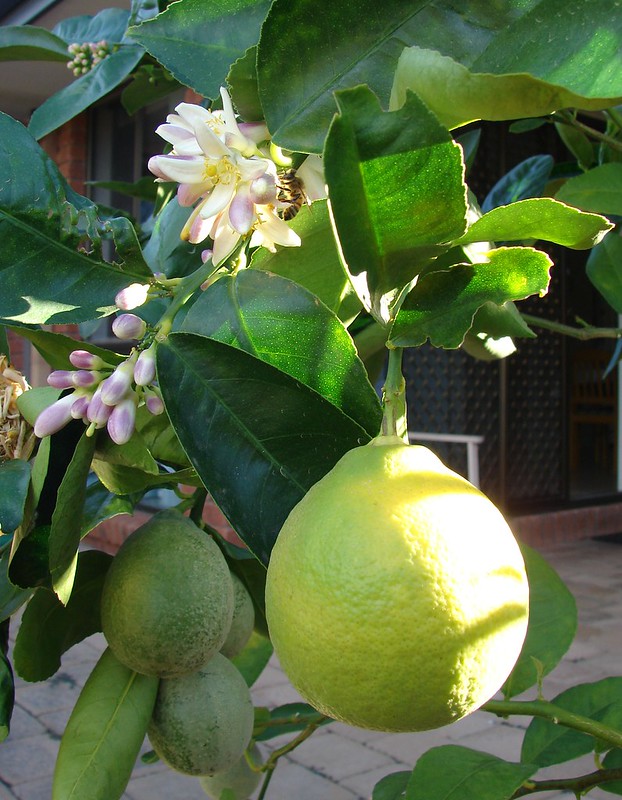
Lemon Tree Growth Stages: A Blossoming Journey
Lemon trees go through several growth stages, including seed germination, sprouting, and vegetative growth with robust foliage and a strong root system. From there, they progress to the flowering stage and eventually produce fruit.
The time it takes for lemon trees to reach these stages varies, with grafted trees typically taking 4-6 years to produce fruit, while seedling trees can take 7-10 years. It can take over 10 years for a lemon tree to start producing a full crop.
Overall, lemon tree growth is a gradual process that requires patience and proper care to ensure successful fruit production.

Credit: natureofhome.com
Understanding The Growth Cycle Of A Lemon Tree
The growth cycle of a lemon tree involves several stages, starting with seed germination and progressing to the emergence of sprouts and young seedlings. As these seedlings mature, they enter the vegetative growth stage characterized by lush foliage and a strong root system.
Overview Of The Lemon Tree Growth Stages:
A lemon tree undergoes several growth stages throughout its life cycle. Understanding these stages is crucial for successful cultivation and harvesting. The growth cycle of a lemon tree can be summarized as follows:
Seed Germination And Early Growth:
- A lemon tree begins its journey as a seed, which needs proper conditions to germinate.
- The seed requires moisture, warmth, and well-draining soil to sprout.
- After germination, the seedling develops a tiny root system and begins to emerge from the soil.
- It is recommended to sow multiple seeds to increase the chances of successful germination.
Vegetative Growth And Branching:
- Once the seedling is established, it enters a period of vigorous vegetative growth.
- The seedling develops leaves and branches, reaching heights of 6-12 inches per month.
- Adequate water, sunlight, and nutrient-rich soil are essential during this growth stage.
- Pruning can help shape the tree and promote lateral branching, resulting in a bushier appearance.
Flowering And Fruiting:
- As the lemon tree matures, it reaches the stage of flowering and fruiting.
- Flowers develop on the tree, usually in clusters, emitting a delightful fragrance.
- Bees and other pollinators play a crucial role in pollinating the flowers, leading to fruit formation.
- The fruits grow over time, changing color from green to yellow as they ripen.
- Factors like sufficient sunlight, proper watering, and appropriate nutrition influence fruit quality.
Remember, the growth cycle of a lemon tree can vary based on various factors, including climate, soil conditions, and care provided. Patience and consistent care are essential for a bountiful lemon harvest.
Stage 1: Seed Germination And Early Growth
The first stage of lemon tree growth is seed germination and early growth. This is where the lemon tree begins its journey, with sprouts emerging and maturing into young seedlings. During this stage, the seedlings develop a strong root system and robust foliage.
Factors Affecting Seed Germination:
- Quality of the seed: High-quality seeds have a better chance of germinating successfully.
- Temperature: The optimal germination temperature for lemon seeds is around 70-85 degrees Fahrenheit.
- Moisture: Lemon seeds require a sufficient amount of moisture to germinate.
- Light: Lemon seeds do not require light to germinate, but they should be exposed to sunlight once sprouted.
Proper Seed Preparation And Planting:
- Soaking: Soak the lemon seeds in water for 24 hours before planting to help speed up germination.
- Soil preparation: Use well-draining soil with a ph level between 5.5 and 6.5. Mix in organic compost to provide nutrients.
- Planting depth: Plant the seeds about half an inch deep in the soil.
Environmental Conditions For Optimal Growth:
- Sunlight: Lemon trees need at least 8-12 hours of direct sunlight each day to thrive.
- Temperature: Lemon trees prefer warm climates and are sensitive to frost. Temperatures between 55-85 degrees Fahrenheit are ideal.
- Humidity: Lemon trees prefer moderate humidity levels, around 50-60%.
Care And Maintenance During The Early Growth Stage:
- Watering: Keep the soil consistently moist but not waterlogged. Water deeply, allowing the soil to dry slightly between waterings.
- Fertilization: Apply a balanced citrus fertilizer every 4-6 weeks during the growing season.
- Pruning: Remove any dead or damaged branches to promote healthy growth.
- Pest control: Monitor for common pests such as aphids or scale insects and treat as necessary.
Remember, proper care and attention during the early growth stage are crucial for the healthy development of your lemon tree. By providing the right environmental conditions and following the recommended care guidelines, you can ensure successful seed germination and early growth.
Stage 2: Vegetative Growth And Branching
During stage 2 of lemon tree growth, known as the vegetative growth and branching stage, the tree develops robust foliage and a strong root system. This stage follows the sprouting of young seedlings and marks an important phase in the lemon tree’s growth journey.
Stage 2: Vegetative Growth And Branching
In this stage of a lemon tree’s growth, several key processes occur to promote healthy development. Here are the main aspects to consider:
Leaf Development And Photosynthesis:
- The tree begins to develop more leaves, which play a crucial role in capturing sunlight for photosynthesis.
- Photosynthesis is the process by which plants convert light energy into chemical energy, allowing them to produce food and grow. Adequate leaf development is essential for this process to occur efficiently.
Promoting Healthy Root Growth:
- As the tree continues to grow, it’s important to ensure healthy root development.
- The roots play a vital role in absorbing water and nutrients from the soil needed for the tree’s overall growth and productivity.
- Providing proper irrigation and drainage, as well as monitoring soil moisture and ph levels, can help promote optimal root growth.
Pruning And Shaping The Tree:
- Regular pruning during the vegetative growth stage helps shape the lemon tree and encourage branching.
- Pruning involves removing dead, damaged, or overcrowded branches to maintain the tree’s overall health and structure.
- Proper pruning techniques also help promote air circulation and sunlight penetration, leading to better overall growth and fruit production.
Here’s more on “How to Remove Dead Tree Branches”
Nutrient Requirements And Fertilization:
- Lemon trees have specific nutrient requirements, and fertilization is essential for healthy growth.
- Nitrogen, phosphorus, and potassium are key nutrients needed for vigorous vegetative growth.
- Using a suitable citrus-specific fertilizer or organic alternatives like citrus mix or compost can help supply the necessary nutrients to support the tree’s development.
Remember, proper care and attention during the vegetative growth and branching stage are crucial for the lemon tree’s future productivity. By focusing on leaf development, root growth, pruning, and nutrient requirements, you can ensure a strong foundation for your lemon tree’s overall growth and well-being.
Stage 3: Flowering And Fruiting
During the third stage of lemon tree growth, known as the flowering and fruiting stage, the tree begins to produce flowers and eventually bear fruit. This stage is characterized by the development of blossoms and the formation of lemons, marking an important milestone in the growth cycle of a lemon tree.
Formation Of Flower Buds:
- Lemon trees go through different growth stages, and the flowering stage is an exciting phase in their lifecycle. Here’s what happens during the formation of flower buds:
- Flower buds begin to form on the lemon tree branches.
- These buds develop over time and eventually turn into beautiful flowers.
- The formation of flower buds is a sign that the lemon tree is ready to produce fruit.
- It is crucial to ensure that the tree has the right conditions for bud development, including adequate sunlight, water, and nutrients.
- Proper care during this stage helps optimize the tree’s fruit production in the next phase.
Pollination And Fruit Set:
- Once the lemon tree flowers bloom, it’s time for pollination and fruit set. Here’s what you need to know about this crucial stage:
- Pollination occurs when bees, insects, or other pollinators transfer pollen from the flower’s stamen to the stigma.
- Pollination is essential for fruit set. Without successful pollination, the flowers may not develop into fruits.
- Lemon trees are self-pollinating, which means they can produce fruit without the need for cross-pollination from another lemon tree.
- However, the presence of pollinators can increase the chances of successful pollination and improve fruit yield.
- After successful pollination, the flowers wither away, and tiny green fruits start to form.
Growth And Development Of The Fruit:
- As the lemon fruits continue to grow and develop, the tree enters the next stage. Here’s what happens during the growth and development of the fruit:
- The green fruits start to enlarge and take on the characteristic oval shape of lemons.
- The fruits gradually change color, turning from green to yellow as they ripen.
- During this stage, it’s important to provide the tree with proper care, including regular watering, fertilizing, and pest control.
- The fruits require sufficient sunlight to ripen fully, so ensure that the tree has optimal sun exposure.
- Pruning any excess branches and thinning out the fruits can help improve the quality and size of the remaining fruits.
Harvesting And Post-Harvest Care:
- Finally, when the lemons are fully ripe, it’s time for harvesting and post-harvest care. Here are some essential steps to follow:
- Harvest the lemons by gently twisting or cutting them from the tree.
- Handle the fruits carefully to avoid any bruising or damage.
- After harvesting, wash the fruits and dry them thoroughly before storage.
- Store the lemons in a cool, dry place away from direct sunlight.
- Check the stored lemons regularly for any signs of spoilage or decay.
- If storing for an extended period, consider preserving the lemons by juicing or freezing them for later use.
- Proper post-harvest care ensures that you can enjoy the fresh and flavorful taste of homegrown lemons for an extended period.
Now that you’ve learned about the flowering and fruiting stages of lemon trees, let’s move on to the next stage of their growth.
Common Challenges And Tips For Successful Lemon Tree Growth
From seed germination to robust foliage, the growth stages of a lemon tree pose common challenges. Tips for successful growth include proper watering, pruning, and fertilization. With patience, a lemon tree can produce a full crop in about 10 years.
Pests And Diseases Management:
- Regularly inspect your lemon tree for common pests such as aphids, scale insects, and citrus leaf miners.
- If you notice any signs of infestation, take immediate action to prevent the pests from spreading further. Use insecticidal soaps or horticultural oils to control the pests effectively.
- Monitor your lemon tree for common diseases such as citrus canker and powdery mildew. These diseases can weaken the tree and affect its overall growth. Apply appropriate fungicides to combat these diseases and protect your tree’s health.
- Proper pruning and maintenance practices can help prevent pest and disease infestations. Remove any dead or damaged branches and keep the area around the tree clean to minimize hiding places for pests.
Soil And Watering Requirements:
- Lemon trees thrive in well-draining soil that is slightly acidic with a ph level between 5.5 and 6.5.
- Before planting your lemon tree, amend heavy clay or sandy soil with organic matter to improve its fertility and drainage.
- Provide sufficient water to your lemon tree, especially during the early growth stages. Water deeply but infrequently, allowing the soil to dry out slightly between waterings. Overwatering can lead to root rot and other moisture-related issues.
- Mulching around the base of the tree helps conserve moisture, suppress weeds, and maintain a stable soil temperature. Use organic mulch such as wood chips or straw, applying it in a 2-3 inch layer.
Protection From Extreme Weather Conditions:
- Lemon trees are sensitive to cold temperatures and frost. If you live in a region with frosty winters, consider planting your lemon tree in a container that can be moved indoors during the cold season.
- In colder regions, you can also protect your lemon tree by covering it with a frost cloth or blanket on nights when frost is expected. This helps retain warmth and prevents damage to the tree.
- In hot and dry climates, provide shade for your lemon tree during the hottest part of the day. Use shade cloth or strategically plant taller trees to provide some relief from the scorching sun.
- Wind can also be damaging to lemon trees, especially in coastal areas or during storms. Consider installing windbreaks or using stakes to support the tree and reduce the risk of toppling.
Tips For Ensuring A Healthy And Productive Lemon Tree:
- Regularly prune your lemon tree to maintain its shape, remove dead wood, and improve airflow. Pruning also helps stimulate new growth and enhances fruit production.
- Fertilize your lemon tree regularly with a balanced citrus fertilizer to provide essential nutrients. Follow package instructions for application rates and timings.
- Monitor the moisture levels of the soil to ensure your lemon tree doesn’t suffer from either under or overwatering. Adjust your watering schedule accordingly.
- Protect your lemon tree from weeds by regularly removing them and applying mulch around the base of the tree.
- Pay attention to signs of nutrient deficiencies such as yellowing leaves or stunted growth. Adjust your fertilization routine or consider soil amendments to address these issues.
- Regularly inspect your lemon tree for signs of pests, diseases, or nutrient deficiencies. Early detection and prompt action can prevent further damage and maintain a healthy tree.
With proper care and attention to these common challenges, you can ensure the successful growth and productivity of your lemon tree. Remember, prevention and regular maintenance are key to keeping your lemon tree thriving throughout its growth stages.
Frequently Asked Questions
How Long Do Lemon Trees Take To Grow?
Lemon trees can take different amounts of time to grow depending on whether they are grafted or from seed. Grafted trees generally take 4-6 years before they start producing fruit, while seedling trees may take 7-10 years to start blossoming.
It can take over 10 years for a lemon tree to start producing a full crop. Generally, lemon trees grow about 6-12 inches per month. This growth pattern includes various stages such as seed germination, sprout development, and vegetative growth characterized by strong roots and lush foliage.
It’s important to note that patience is required when growing lemon trees as they take time to mature and bear fruit.
What Is The Growth Pattern Of A Lemon Tree?
Lemon trees have a specific growth pattern that progresses through different stages. The growth starts with seed germination, where the seed sprouts and begins its journey. As the seedling develops, it enters the vegetative growth stage, characterized by vigorous foliage and a strong root system.
During this stage, the tree grows about 6-12 inches each month. Grafted lemon trees usually take 4-6 years to start producing fruit, while seedling trees can take 7-10 years to start blooming. It can take over 10 years for a lemon tree to produce a full crop.
Overall, the growth pattern of a lemon tree involves the initial germination, followed by the development of seedlings and the transition to the vegetative growth stage. The tree requires time and patience before it reaches maturity and starts producing fruit.
How Big Is A 2-Year-Old Lemon Tree?
A 2-year-old lemon tree typically reaches a height of 2-3 feet tall.
What Time Of Year Do Lemon Trees Bud?
Lemon trees bud at different times of the year depending on the specific variety and climatic conditions. Generally, lemon trees tend to bud in the spring season when the temperature starts to warm up. This is usually around the months of March to May.
During this time, the lemon tree produces new growth in the form of buds and leaves. It is important to note that lemon trees require a certain amount of warmth and sunlight to initiate budding. However, the exact timing of bud formation can vary based on factors such as geographic location, weather patterns, and tree health.
It is recommended to monitor the tree closely and provide appropriate care to ensure optimal bud formation and growth.
Conclusion
As your lemon tree progresses through its growth stages, it undergoes a remarkable transformation. Starting with seed germination, the tree emerges from the ground as sprouts and matures into young seedlings. As these seedlings continue to develop, they enter the vegetative growth stage, characterized by lush foliage and a strong root system.
This stage sets the foundation for the tree’s future growth and productivity. Over time, with proper care and maintenance, your lemon tree will reach maturity and begin producing fruit. The length of this journey varies depending on the type of tree, with grafted trees typically taking 4-6 years to bear fruit, while seedling trees may take 7-10 years.
Remember to provide adequate sunlight, water, and nutrients along the way to ensure optimal growth and abundance. By understanding the lemon tree growth stages and providing the necessary care, you can enjoy the rewards of your own homegrown lemons in due time.
Happy gardening!
Relevant Topics
10 Best Small Evergreen Trees with Non Invasive Roots
 Dr Ahsanur Rahman, PHD
Dr Ahsanur Rahman, PHDPine Tree Rescue: Saving Pine Trees with Brown Needles
 Dr Ahsanur Rahman, PHD
Dr Ahsanur Rahman, PHD








